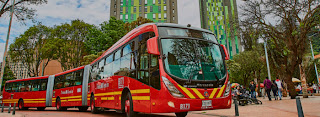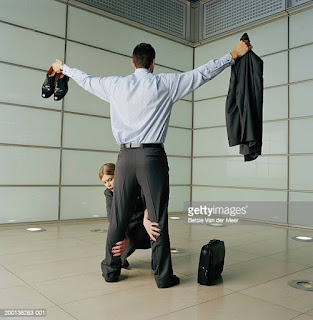COLOMBIA 2: DESPLAZARSE EN BOGOTÁ - UBER ILEGAL Y BUSES ENORMES / GETTING AROUND BOGOTÁ - ILLEGAL UBER AND HUGE BUSES
10-08-22
(English below)
El gran problema de Bogotá es el transporte.Debe ser la ciudad más grande de América Latina que no
tiene metro – sólo tiene un sistema de autobuses que se llama el Transmilenio. Esta
red tiene autobuses enormes de color rojo que pueden transportar a 200 personas
a la vez – de hecho son como tres autobuses en uno. Ellos van por las carreteras principales y tienen
sus propios carriles donde sólo los buses pueden circular.
También hay otros buses normales de color azul que son
como distribuidores, que llevan a la gente de las estaciones principales a los
barrios y zonas más en el interior de la ciudad.
El problema es que tienes que entender como funciona el
sistema, hay que conocer un poco la geografía de la ciudad y, después de todo
eso, sólo se puede viajar con una tarjeta especial que sólo puedes comprar en
ciertos puntos. No te lo hacen fácil, sobre todo para los extranjeros que sólo
pasan 6 días aquí.
Por eso, toda la gente utiliza Uber. Llevo 5 días aquí y
he perdido la cuenta del número de viajes que he hecho en Uber. Es fácil, barato
y normalmente conveniente.
A pesar de eso, no me gusta mucho. Muchas veces los coches
– los “carros”, como dicen aquí – no están en condiciones, no tienen nada que
ver con los Uber que se toma en Madrid, por ejemplo, que normalmente son coches
cómodos, incluso de lujo. El otro día reservé un viaje con Uber, y llegó un tío
en una camioneta, que parecía ser de un constructor o granjero.
Además es común que el conductor tenga la radio puesta
muy alta, y te obliga a escuchar los ‘hits’ de los 80, o remixes de reggaetón o
lo que pongan ahí a alto volumen.
Asimismo, como ya he comentado, el tráfico en Bogotá es
complicado, y a menudo te encuentras en un atasco que se avanza muy lentamente.
Viajes relativamente cortos te pueden durar hasta una hora.
Como he dicho, toda la gente toma Uber, pero en realidad
es ilegal. Si la policía para a un conductor, puede examinar su móvil, interrogar
a su pasajero para saber si trabaja para Uber y, si el pasajero admite que sí,
la poli puede confiscar su coche y prohibirle al conductor conducir por años. El
pasajero no está en peligro, pero algunos se asustan y delatan al conductor.
Todo eso según los muchos conductores con quién he
viajado en los últimos días. Algunos tienen tanto miedo de las autoridades que
te piden que viajes en el asiento delantero y no de atrás, para que no parezca
que están llevando a un pasajero.
Vale la pena repetir, toda la gente utiliza Uber. Es
muy, muy común. Y toda la gente sabe eso – políticos, policía, autoridades de
todo tipo – pero sigue siendo ilegal. Es una de las contradicciones de la
sociedad colombiana, una de las muchas, supongo. Para alguna gente Uber es la
única manera de viajar por la ciudad, dado que los taxistas tienen mala fama de
estafadores y ladrones (aunque eso también es exagerado, creo yo).
Para terminar, es interesante mencionar una de las estrategias
que las autoridades en Bogotá han implementado para controlar el tráfico. Se
llama Pico y Placa. Si tu matricula (o “placa”, como dicen aquí) termina en un
número impar, no puedes utilizar tu coche en un día impar durante las horas
punta. O sea, si tu matricula es HWV349, no puedes sacar el coche días 1, 3, 5,
7 etc, durante las horas de mucha actividad de la mañana y tarde. Lo mismo se
aplica con los números pares.
Sin embargo, hay una manera de evitar esta ley. Pagando una
tarifa especial, tienes el derecho de conducir cuando quieras, no importa el
día. Como siempre, la gente con dinero puede salirse con la suya, mientras la
gente normal tiene que tener la responsabilidad para cumplir la ley.
https://www.colture.co/bogota/general-info/transportation-getting-around/navigating-bogota/
The big
problem with Bogotá is getting around.
It must be
the largest city in South America without a metro – it has almost the
population of London but as far as public transport is concerned, it only has a
system of buses that they call the Transmilenio. This consists of hugely long,
red articulated buses that can hold up to 200 people each; they are actually
like three buses in one. These long snake-like buses go down the main roads and
highways and have their own lanes where only buses can follow.
Then there
are normal-sized blue buses that act as distributors from the larger
Transmilenio stations. They ferry people out to the suburbs or into the centre
of the city.
The issue is
that you have to understand how the system works, you have to know something
about the geography of the city and, on top of that, you can only travel by
using a prepaid card that you can only buy in one of the specific stations or
centres around the city. They don’t make it easy for you, and especially not
for foreigners that are only spending 6 days in the city.
For this,
and other reasons, nearly everyone uses Uber. I have been here for 5 days and
have lost count of the Uber journeys that I have taken. It is easy, cheap and
normally convenient.
Despite
this, I don’t really like it. Often the cars are not in great shape and this is
made worse when they are driving over some of the dodgy roads here in Bogotá.
The other day I reserved an Uber and a dude showed up in a pick-up truck that
looked like it belonged to a builder or farmer. I hopped in the front and it
was actually one of the more comfortable trips I have had, but you just never
know.
And then you
have the drivers that have the radio blasting when you get in, and for 40 minutes
you have to listen to 80’s hits, or stations devoted to just Roxette (that’s
what it seems like!) or reggaeton remixes, or whatever they have on. It can be
a pain. And with the constant “trancones” in the city – the traffic jams that
are everywhere – it can get tiring. Fairly short journeys can last 40, 50
minutes or more.
As I said
above, nearly everyone takes Uber here, but it is in fact illegal. The app is
legal and drivers can sign up, but if the police stop a driver, they can look
at his phone (all the Uber drivers are men, as far as I can see), question his
passenger and, if the passenger admits that they are travelling in an Uber, the
police can confiscate the car and ban the driver for years. The passenger is
not in any danger, but some get scared and tell the police what is happening.
This is all
according to the many drivers who I have spoken to in the last 5 days, who have
become my main source of info about the city and how things work. Some drivers
are so scared of being stopped that they ask you to sit in the front seat and
not in the back, so that it doesn’t look like they are carrying a passenger.
It is worth
mentioning that everyone uses Uber here. It is very common. And that includes
police and politicians, according to drivers. Everyone knows how common it is,
but it is still illegal. It is one of the contradictions of Colombian society,
one of many, I suppose. For many people it is the only way that they travel
around the city, given that taxi drivers have a bad name here, although this is
coming from Uber drivers. I think it is exaggerated, but they say that taxis
will rip you off or even steal from you, if they can.
To finish
talking about transport here, it is interesting to mention one of the strategies
that the local authorities here have to control the traffic. It is called Pico y Placa. The “placa” part of this is the number plate of your car. If your
plate ends in an odd number, you cannot use your car at rush hour on odd numbered
dates, or you will be fined. In other words, if your registration is HWV349,
you cannot take your car into the city on the 1st, 3rd, 5th,
7th, of the month at the busy morning and evening times. The same
applies with the even numbers.
There is a
way around it though. You can pay a daily fee and this gives you the right to use
your car whenever you want. It doesn´t seem very fair; it means that if you
have money, you can get around the law that is designed to control traffic
flow, and so it ends up being poorer people that are stuck with the responsibility
of keeping the roads open. Nothing new there, I suppose.




Comments
Post a Comment